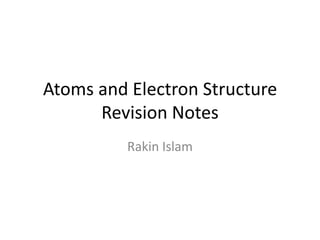
Atoms and Electron Structure
- 1. Atoms and Electron Structure Revision Notes Rakin Islam
- 2. Atomic Structure • The nucleus contains almost all of the mass of an atom as that is where the protons and neutrons are found • The nucleus of an atom contains all of the positive charge • The electrons are outside the nucleus and, therefore, so is the negative charge • Atomic number = number of protons in the nucleus • Mass number = number of protons and neutrons in the nucleus • Number of neutrons = mass number – atomic number • Number of electrons = number of protons (in a neutral atom) 9 Mass number = 9, Atomic number = 4 Be 4 4 protons, 5 neutrons, 4 electrons Relative mass Relative charge Proton 1 +1 Neutron 1 0 Electron 1/2000 -1
- 3. Isotopes and ions • • • • • • Isotopes are atoms with the same number of protons but different numbers of neutrons (and different masses) For example, chlorine has two isotopes 35Cl and 37Cl. Both have 17 protons but they have 18 and 20 neutrons, respectively Isotopes of an element have the same chemical properties because they have the same electron arrangement Ions are formed when atoms gain or lose electrons. As an atom Cl has 17 electrons. A Cl- ion has gained one electron so it now has 18. As an atom Na has 11 electrons. A Na+ ion has lost one electron so it now has 10.
- 4. Relative atomic mass • • • • • • • • • • • • Relative atomic mass is the average mass of an atom of an element taking the mixture of isotopes into account. However, learn the technical definition from definitions sheet To calculate relative atomic mass, add together (mass number x percentage/100) for each isotope Example: 75% of Cl atoms have a mass number of 35 25% of Cl atoms have a mass number of 37 Average mass of a Cl atom = (mass no x percent/100) + (mass no x percent/100) = (35 x 75/100) + (37 x 25/100) = 35.5 For simple molecules, such as O2 and H2O, the relative molecular mass is calculated by adding the relative atomic masses of the elements involved, giving 32.0 for O2 and 18.0 for H2O For giant structures, such as Na2S and SiO2, the relative formula mass is calculated by adding the relative atomic masses of the elements involved, giving 68.1 for Na2S and 60.1 for SiO2
- 5. Orbitals • • • • • An orbital is a region that can hold up to two electrons. Orbitals have different shapes called s, p, d, and f (but f orbitals are beyond our syllabus) S orbitals are spherical in shape and come in sets of one (which can hold up to 2 electrons) P orbitals are hour-glass or egg-timer shaped and come in sets of three (which can hold up to 6 electrons) D orbitals come in sets of five which can hold up to 10 electrons
- 6. Energy levels (or shells) • • • • • • • • The first energy level (or shell) only contains an s orbital, labelled 1s The first shell can hold up to 2 electrons The second energy level contains an s orbital (labelled 2s) and three p orbitals (labelled 2p) The second shell can hold up to 8 electrons The third energy level contains an s orbital, three p orbitals and five d orbitals The third shell can hold up to 18 electrons The order in which the orbitals are filled is as follows: 1s 2s 2p 3s 3p 4s 3d 4p Note that the 4s fills before the 3d • • • • • • • Some examples of electronic structures are shown below. Hydrogen 1 electron 1s1 Nitrogen 7 electrons1s2 2s2 2p3 Sodium 11 electrons 1s2 2s2 2p6 3s1 Sulphur 16 electrons 1s2 2s2 2p6 3s2 3p4 Calcium 20 electrons 1s2 2s2 2p6 3s2 3p6 4s2 Iron 26 electrons 1s2 2s2 2p6 3s2 3p6 4s2 3d6
- 7. Energy levels (or shells) cont. • • • • In a Cl- ion, the 18 electrons are arranged 1s2 2s2 2p6 3s2 3p6 In a Na+ ion, the 10 electrons are arranged 1s2 2s2 2p6 Transition metals, like iron, lose their 4s electrons first (before 3d). Fe3+, with 23 electrons, is 1s2 2s2 2p6 3s2 3p6 4s0 3d5 The diagram below shows the relative energies of the orbitals from 1s to 4f
- 8. Successive Ionisation Energies • • • • • • • • • • • Evidence that electrons are arranged in shells or energy levels can be obtained by measuring the successive ionisation energies of an element The first ionisation energy of an element is the energy needed to remove one mole of electrons from one mole of gaseous atoms i.e. M(g) M+(g) + eNote - State symbols are essential in ionisation equations In general, ionisation is easier if the nuclear charge is smaller, the electron is further away from the nucleus and there is more shielding from inner electron shells. For an element, successive ionisation energies get bigger because the remaining electrons are held more tightly by the unchanged nuclear charge. Jumps in ionisation energies occur when going from one energy level (shell) to another. This tells you which group the element is in. The jump in energy occurs because the new energy level is closer to nucleus and less shielded.
- 9. Blocks in the Periodic Table • • • • An element can be assigned to the s, p or d block by working out which type of orbital its outermost electron is in The s block is groups 1 and 2 The p block is groups 3 to 8 The d block is between the s and p blocks
